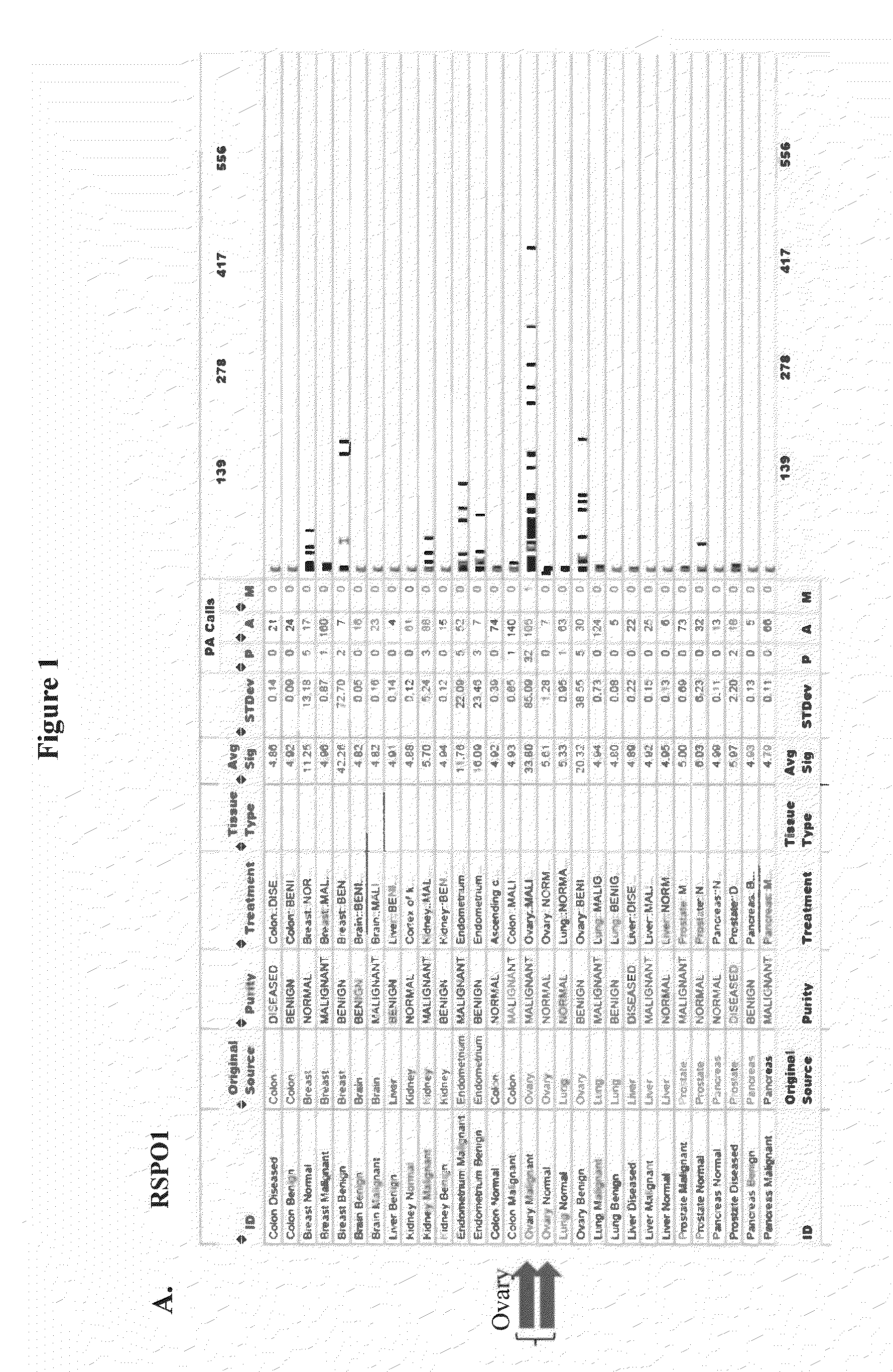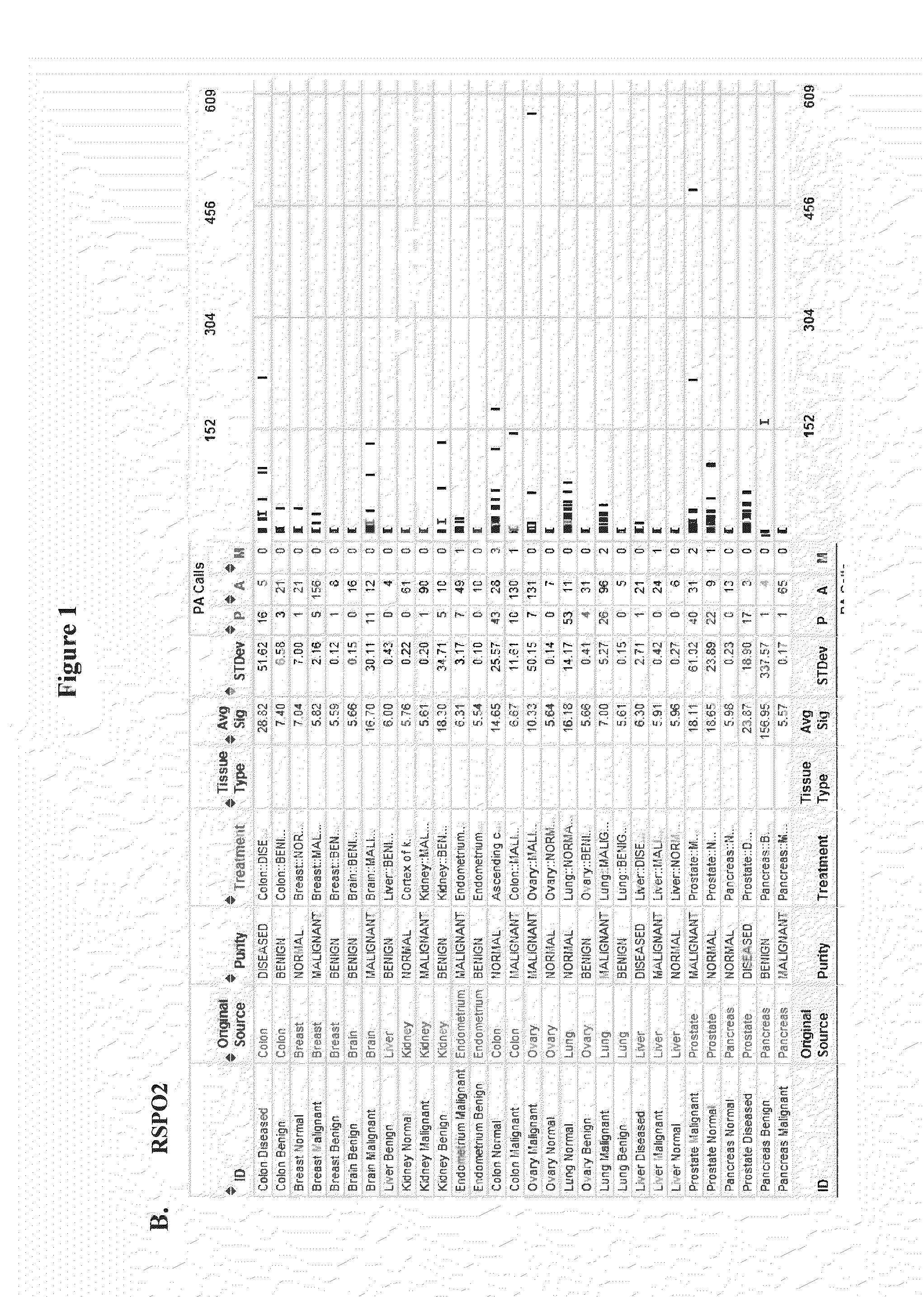RSPO Binding Agents and Uses Thereof
a technology of rspo and binding agents, applied in the field of antibodies and other agents, can solve the problems of uncontrolled proliferation and maintain tumor cells in an undifferentiated state, and achieve the effects of reducing the frequency reducing the number of cancer stem cells, and inhibiting tumor growth
- Summary
- Abstract
- Description
- Claims
- Application Information
AI Technical Summary
Benefits of technology
Problems solved by technology
Method used
Image
Examples
example 1
Expression of RSPO and LGR in Human Tumors
[0283]mRNA from normal tissue, benign tumor and malignant tumor samples of a large number of human patients was analyzed by microarray analysis (Genelogic BioExpress Datasuite). This data revealed elevated expression levels of RSPO1 in malignant tissue relative to normal tissue in several tumor types including kidney, endometrial, and ovarian. RSPO1 was noted to be frequently over-expressed in ovarian cancer (FIG. 1A). In addition, this data suggested elevated expression levels of RSPO3 in malignant tissue relative to normal tissue in several tumor types including ovarian, pancreas, and lung (FIG. 1C). In addition, it was found that LGR5 and LGR6 were over-expressed in malignant breast tumors, colon tumors, lung tumors, and ovarian tumors relative to normal tissue, while LGR4 was over-expressed in lung tumors. LGR5 and LGR6 over-expression appeared to be restricted to triple-negative (ERnegPRnegHER2neg) breast tumors relative to other breast...
example 2
Binding of RSPO Proteins to LGR5
[0286]A cell surface LGR5 protein was generated by ligating amino acids 22-564 of human LGR5 to an N-terminal FLAG tag and to the transmembrane domain of CD4 and a C-terminal GFP protein tag using standard recombinant DNA techniques (FLAG-LGR5-CD4TM-GFP). RSPO-Fc constructs were generated using standard recombinant DNA techniques. Specifically, full-length human RSPO1, RSPO2, RSPO3 and RSPO4 were ligated in-frame to a human Fc region and the recombinant RSPO-Fc proteins were expressed in insect cells using baculovirus. The fusion proteins were purified from the insect medium using protein A chromatography.
[0287]HEK-293 cells were transiently transfected with the FLAG-LGR5-CD4TM-GFP construct. After 48 hours, transfected cells were suspended in ice cold PBS containing 2% FBS and heparin and incubated on ice in the presence of 10 μg / ml RSPO1-Fc, RSPO2-Fc, RSPO3-Fc, RSPO4-Fc, or FZD8-Fc fusion proteins for 15 minutes. A second incubation with 100 μl PE-c...
example 3
In Vitro Testing for Inhibition of β-Catenin Signaling
[0291]To prepare cell suspensions, fresh human lung adenocarcinoma xenograft tumors (lung tumor #1 in Table 2) propagated in NOD / SCID mice were minced and digested in medium 199 (Invitrogen, Carlsbad, Calif.) containing 300 U / ml collagenase type 3 (Worthington, Lakewood, N.J.) and 200 U / ml DNase I (Worthington, Lakewood, N.J.) for 1 to 2 hours at 37° C. The lung tumor cells were filtered through a 40 μm nylon strainer (BD Falcon, Franklin Lakes, N.J.), and spun down at 82×g for 5 minutes. Red blood cells were lysed in ACK buffer (0.8% ammonium chloride, 0.1 mM EDTA, 10 mM sodium bicarbonate, 0.1N HCl), washed, and centrifuged at 150×g for 5 minutes in medium consisting of HBSS (Mediatech, Manassas, Va.), 25 mM HEPES buffer (Mediatech, Manassas, Va.) and 2% heat-inactivated fetal bovine serum (HI-FBS; Invitrogen, Carlsbad, Calif.). Dead cells and debris were removed by centrifugation on a cushion of HI-FBS at 82×g for 8 minutes. M...
PUM
| Property | Measurement | Unit |
|---|---|---|
| concentrations | aaaaa | aaaaa |
| concentrations | aaaaa | aaaaa |
| temperature | aaaaa | aaaaa |
Abstract
Description
Claims
Application Information
 Login to View More
Login to View More - R&D
- Intellectual Property
- Life Sciences
- Materials
- Tech Scout
- Unparalleled Data Quality
- Higher Quality Content
- 60% Fewer Hallucinations
Browse by: Latest US Patents, China's latest patents, Technical Efficacy Thesaurus, Application Domain, Technology Topic, Popular Technical Reports.
© 2025 PatSnap. All rights reserved.Legal|Privacy policy|Modern Slavery Act Transparency Statement|Sitemap|About US| Contact US: help@patsnap.com



